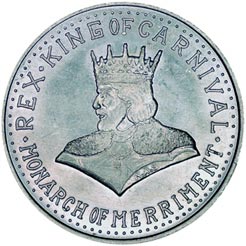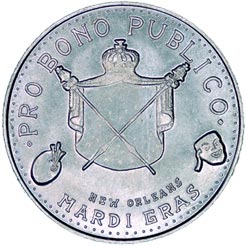MARDI GRAS CELEBRATION
(CIRCA 1960)--Undated
NEW ORLEANS, LA
Purpose: To celebrate, with "wholesome fun, spontaneous gaiety and feasting," season just prior to Lenten period of fast; termed by visitors "greatest free show on earth."
History, Organization: Literally, Mardi Gras means "Fat Tuesday" or Shrove Tuesday--day before Ash Wednesday. Originally, celebration was European custom but New Orleans' observance, in form of balls and masquerade dances, apparently started soon after colony founded. Street pageants, with public masking, began about 1857; Rex, King of Carnival, appeared first in 1872.
"Carnival" and "Mardi Gras" not synonymous; former opens officially Jan. 6, marked by succession of elaborate private balls; latter begins two weeks before Shrove Tuesday, includes balls but features street parades and masking, general public and visitors participating. Today, dozens of Carnival organizations holds annual balls and stage parades.
Site, Dates, Attendance: City-wide celebration. Mardi Gras serves as "climax of Carnival season"; 500,000 of visitors attracted each year to a city of similar size.
Comment: Most Carnival and Mardi Gras balls include elaborately costumed tableaus. Captain of each organization and secret committee select King, Queen, Royal Court and Krewe who comprise cast; theme can be historical, poetical, etc., or purely imaginative. Guests are merely spectators during formal program; later participate in general dancing.
With advent of Mardi Gras proper, street parades and pageants take over, night and day. Rex organization selects Rex, King of Mardi Gras, always some outstanding civic leader, usually a member of the Boston Club (old conservative and Christian club). The Queen of Rex Carnival (almost always a debutante) and the Maids of the Rex Court are known as the "Carnival Court"; no other organization entitled to use that designation. Holds parade on Mardi Gras day, Shrove Tuesday; holds ball that night, bringing entire celebration to close.
Medals: Issued for first time in 1960 by School of Design, official name of Rex organization; designed by H. A. Sharpe; struck by Crofters, Inc., Chicago. Issue consisted of 30 sterling Silver, twice thickness of Aluminum, about 3,000 gold-anodized Aluminum and 125,000 plain Aluminum pieces. Medals, other than plain Aluminum, were presented to special guests and officials; plain Aluminum used as "throw" pieces, i.e. tossed to crowds by Rex, King of Mardi Gras. Beginning 1961, similar medals were dated.


Photos courtesy of Tom Hoffman
Obv. Crowned head and bust l., with letters H.A.S in exergue on r. base of bust; above Rex King of Carnival; below bust, around Monarch of Merriment; beaded border.
Rev. Coat of Arms of School of Design; at lower l. is artist's palette with brushes; at lower r. is face mask; above coat of arms • Pro Bono Publico •; below coat of arms New Orleans / Mardi Gras; beaded border.
HK-579 .999 Silver. Undated. 40mm.
HK-579a .999 Silver. Dated 1960.
HK-579b .999 Silver. UNIFACE.
HK-579c Copper. UNIFACE.
HK-580 Aluminum, gold-anodized (bright). Undated.
HK-580a. Aluminum. Gold-anodized (bright). Dated 1960.
HK-581 Aluminum, plain.
Restrikes of the gold and plain were reproduced in the 1970's and were known as the NORD (New Orleans Recreation Dept.) restrike or fake. There are ways to tell the difference between the originals and the restrikes. While the original strikings were very crisp, the restrikes show a loss of detail, particularly in the beading on the obverse and reverse. Additionally, the reverse exhibits many "bumps" or "mumps" in the shield and fields.
To tell the difference between the original strikes and the NORD restrikes, examine the back of the doubloon. On the original, the cloak has small pit-looking marks as if the black spots on a white fur. On the restrikes, the pit-looking marks are not restricted to just the cloak but extend across the entire reverse. Also, the rim on a 1960 original strike is full, while on must restrikes the bottom rim is found to be weak. The restrikes are known in both Gold and Silver. NOTE: The original 1960 undated Gold also has a very slight waviness on the surface of the doubloons.
HK-578 HK-582 to HK-585